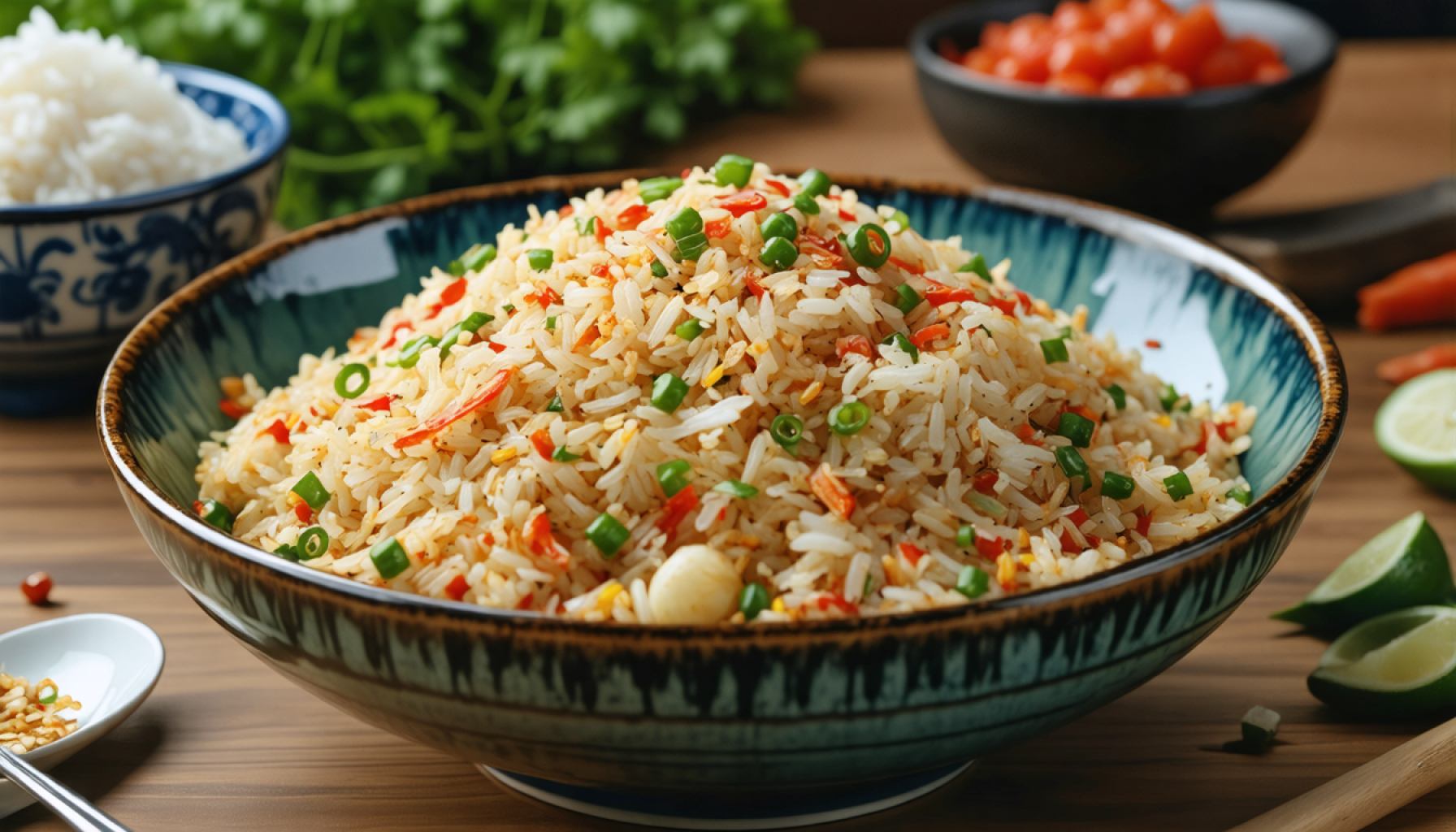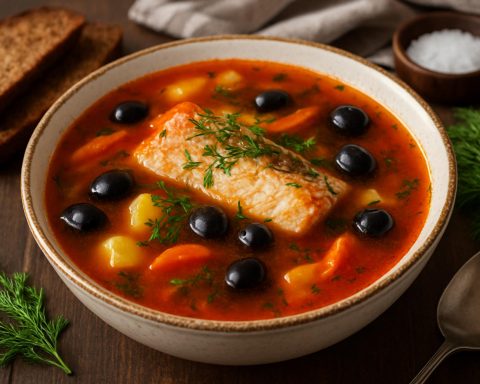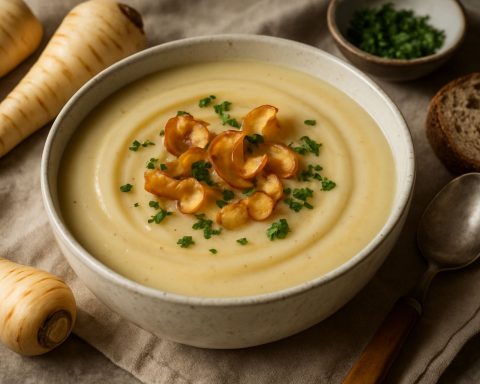Korean Fried Rice, or Kimchi Bokkeumbap, is more than a dish—it’s a delicious way to explore Korea’s rich cultural tapestry. Emerging from the ingenious practice of using leftover rice and kimchi, this dish bursts with flavor while reducing waste. The magic behind its taste lies in the interplay between the sour tang of aged kimchi, savory nuances of soy sauce, and the velvety warmth of a freshly cracked egg. It’s the ultimate comfort food, perfect for weeknight dinners or as a show-stopping side at gatherings.
Ingredients:
– 2 cups of cooked rice (preferably cold and day-old)
– 1 cup of kimchi, chopped
– 100g pork belly or chicken, diced (optional)
– 2 tablespoons of soy sauce
– 1 tablespoon of gochujang (Korean chili paste)
– 2 eggs
– 2 green onions, sliced
– 2 tablespoons of sesame oil
– 1 teaspoon of sesame seeds
Instructions:
1. Prepare the base: Heat sesame oil in a large pan over medium heat. Add the diced pork belly or chicken if using, and sauté until cooked through.
2. Sauté the aromatics: Stir in chopped kimchi and gochujang, cooking until fragrant, about 2 minutes.
3. Add the rice: Toss in the cold rice, breaking up any clumps. Drizzle soy sauce over the top, mixing until evenly coated.
4. Create the eggy finale: Push the mixture to one side of the pan, crack the eggs onto the other side, scrambling slightly, then fold into the rice.
5. Finish with flair: Sprinkle sliced green onions and sesame seeds. Serve hot and savor the symphony of flavors.
Exploring the Health Benefits of Kimchi Fried Rice
Kimchi Fried Rice, known as Kimchi Bokkeumbap, offers more than just a taste of Korea’s culinary tradition; it serves a bowl full of potential health benefits powered by its vibrant ingredients. This dish takes traditional Korean flavors, originally crafted from leftover staples, to create a healthful meal that provides both comfort and nourishment.
The Health Benefits of Kimchi Fried Rice and Its Ingredients
1. Kimchi: The Probiotic Powerhouse
– At the heart of kimchi fried rice is kimchi, a fermented Korean staple known for its rich probiotic content. Probiotics are beneficial bacteria that support digestive health, enhancing gut flora and improving digestion. Regular consumption of kimchi can contribute to a stronger immune system, reduced inflammation, and better overall gut health.
2. Rice: A Source of Energy
– The rice used in this dish, preferably cold and day-old, is a great source of carbohydrates, providing energy to keep you active throughout the day. When cooked and cooled, rice also forms resistant starch, which functions like fiber and supports a healthy digestive system.
3. Protein: From Pork Belly or Chicken
– Adding protein through pork belly or chicken transforms this dish into a complete meal. Protein is essential for muscle repair, growth, and overall body function. Opting for lean chicken can make the dish lower in fat while maintaining its nutritional benefits.
4. Soy Sauce: A Nutrient-Rich Flavor Enhancer
– Soy sauce not only lends a savory depth to dishes but also contains essential nutrients like niacin, riboflavin, and selenium. While it should be consumed in moderation due to its sodium content, it enriches the dish’s flavor profile.
5. Gochujang: Metabolism Boosting Heat
– Gochujang, or Korean chili paste, is not just for spice enthusiasts; it contains capsaicin, known for boosting metabolism and aiding in weight management. Additionally, it plays a role in reducing appetite, which can help in controlling calorie intake.
6. Eggs: The Complete Protein
– Eggs provide high-quality protein and essential amino acids. They are also an excellent source of vitamins and minerals, including vitamin B12, vitamin D, and selenium. Incorporating eggs in the final stage adds a creamy texture and additional nutrients.
7. Sesame Oil and Seeds: Heart-Healthy Fats
– Sesame oil and seeds are known for their healthy fats, particularly polyunsaturated and monounsaturated fats. These contribute to cardiovascular health by maintaining cholesterol levels. Plus, sesame seeds are rich in lignans, which have antioxidant properties.
8. Green Onions: Crunchy Nutrition
– Green onions are more than a garnish; they are packed with vitamins A and C, essential for immune function and skin health. Their fresh and mild flavor complements the robust profile of the dish.
Kimchi Bokkeumbap not only provides a sensory delight with its peaceful balance of flavors but also offers a nutritious and health-promoting meal. By embracing traditional ingredients with significant health benefits, this dish is a testament to how delicious and health-conscious cooking can go hand in hand. Serve this meal as a comforting solo dish or delight guests as a sumptuous side, all while nourishing the body from the inside out.
Unlocking the Secrets of Kimchi Bokkeumbap: A Timeless Korean Culinary Tradition
Kimchi Bokkeumbap, widely loved in Korean cuisine, has grown beyond its humble origins to captivate tastebuds worldwide. This dish is not just a testament to the ingenuity of reducing food waste but also a brilliant canvas for culinary innovation. As more people embrace global cuisine, Kimchi Bokkeumbap stands out, offering a blend of flavors that’s both traditional and adaptable.
Innovations in Kimchi Bokkeumbap
Recent trends in culinary circles have pushed traditional recipes like Kimchi Bokkeumbap into new territories of flavor. Chefs are experimenting by integrating additional unconventional ingredients such as quinoa or brown rice to cater to more health-conscious consumers. Some have even explored vegan and vegetarian variations, substituting meats for tofu or tempeh without compromising the savory essence that characterizes the dish.
Nutritional Insights and Health Benefits
Kimchi, a fermented product, is packed with probiotics, which are beneficial for gut health. Incorporating more probiotics into one’s diet can improve digestion and boost immune functions. Additionally, by adjusting the recipe, like minimizing the amount of added oils or substituting meats, Kimchi Bokkeumbap can be tailored to fit diverse dietary needs.
Comparisons with Similar Global Dishes
While Kimchi Bokkeumbap shares similarities with fried rice dishes from countries like Thailand’s Khao Pad or Indonesia’s Nasi Goreng, its unique flavor profile marked by spicy, tangy kimchi differentiates it. Where Khao Pad might use fish sauce and lime, or Nasi Goreng uses shrimp paste, Kimchi Bokkeumbap incorporates fermented cabbage to deliver its signature taste.
Sustainability and Reducing Food Waste
In line with global sustainability efforts, dishes like Kimchi Bokkeumbap emphasize utilizing leftover ingredients, particularly rice. This cooking practice not only extends the shelf life of fresh foods but also aligns with the broader movement of minimizing food waste. As more households and restaurants adopt these practices, the environmental impact of food consumption can be significantly reduced.
Market Analysis and Global Adaptation
With Korean culture and cuisine gaining popularity internationally, dishes like Kimchi Bokkeumbap are quickly becoming staple offerings in restaurants beyond Korean borders. The global fascination with Korean pop culture, particularly K-pop and K-dramas, has also significantly boosted interest in Korean foods. Consequently, food producers strive to make Korean ingredients more accessible, with products like gochujang now widely available in supermarkets across the globe.
For a deeper dive into Korean cuisine and to explore an array of authentic product selections, visit the Korean Cooking Domain.
Discovering and experimenting with dishes like Kimchi Bokkeumbap not only enriches the culinary landscape but also offers a cultural exchange that can bring the world closer together, one bite at a time.








